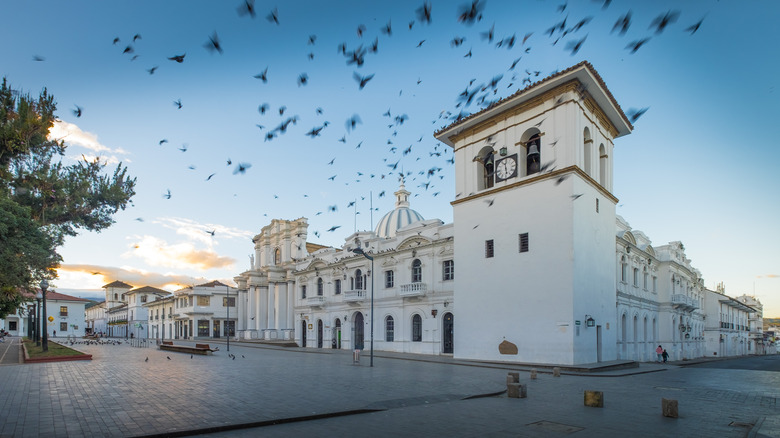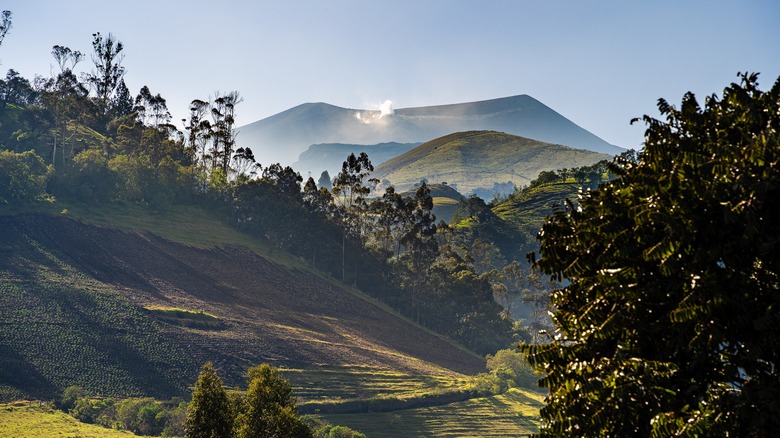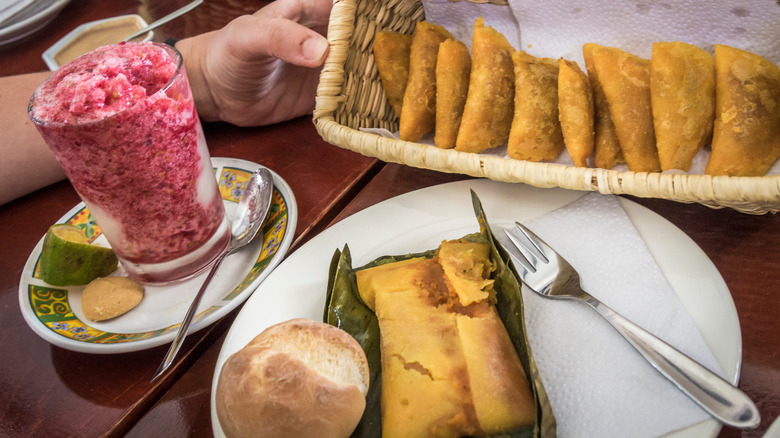Most Tourists Have Yet To Discover Colombia's Breathtaking 'White City'
Whitewashed walls and neat Andalusian streets stand stark against the verdant hills of the Valle de Pubenza in western Colombia. The Spanish-style architecture of the city of Popayán has been carefully preserved, second only to Cartagena (a city on Colombia's Caribbean coast) in its commitment to colonial construction. In Popayán, it's easy to see the influences that formed the country's modern personality. Visitors can wander along ivory lanes, peer inside grandiose cathedrals, view giant Indigenous artwork, and taste the flavors of West Africa. Colombia's multifaceted culture is woven together in this place — "the white city."
While it strays from the typical trail taken by travelers to Colombia, Popayán is still straightforward to access. Daily flights run to Popayán from Bogotá's international airport and buses run regularly from Cali. You can even catch a ride from the 'City of Eternal Spring,' if you're feeling adventurous enough to embark on an overnight bus. Colombia's climate is generally consistent: it rains or it storms. Travel south of the major cities during the summer for the best chance of bypassing the worst of the wet season.
Explore colonial history and pre-Hispanic heritage in Popayán, Colombia
Ostentatious mansions and Potosí silver-plated alters hint at Popayán's place on Spain's rich trading routes through South America. Connecting the old exchange roads between Lima, Quito, and Cartagena, many prominent businessmen set about building grand homes for themselves in the wealthy city. During the era of the conquistadors, the central plaza of Popayán was a slave-trading center for the Spanish empire. Furthermore, it was a trading point for the wealth of natural resources that were extracted and hauled to Spanish ports on the coast. Today, you can sit on the steps of the cathedral, in the shadow of the 17th-century clocktower, and take in the history that seeps from the brickwork into the city.
Take a less macabre excursion to Tierradentro Archaeological Park, an easy day trip from Popayán's city center. This UNESCO-protected world heritage site conceals massive tombs and human statues, dating back before the arrival of the Spanish in Popayán. The pre-Columbian crypts, carved into volcanic rock, still bare their painted decals, despite having been built between A.D. 600 and 900. Alternatively, immerse yourself in the nature of the vast volcanic valley on a day trip to Puracé National Natural Park. The lava-carved canyons, sulphur springs, and alpine lagoons are frequented by some of Colombia's endemic wildlife.
Eat your way through the first UNESCO City of Gastronomy
Popayán didn't snare the first UNESCO designation as a City of Gastronomy because its snacks are particularly tasty. It didn't need to compete with the meticulous techniques of Japanese chefs or iconic Italian dishes. Instead, Popayán earned the title through the community's commitment to using traditional preparation methods for its unique cuisine. Blending Andean, African, and Spanish practices and flavors, recipes have been passed down for generations through the oral tradition of the city.
On the street, you can taste tamales or empanadas stuffed with pipián, a puree of potatoes, peanuts, and spices. You can also try carantantas, crispy shavings of fried tortilla dough. Grab a window-side seat at Balcón de los Santos for church views and typical fare, or sample an array of traditional drinks and snacks at Mora Castilla. Beverages play a big role in the local food scene. Native ingredients like corn, lulo, guanabana, and mora are all major players in filling the plastic cups flowing on street corners. When you've enjoyed your fill of Popayán, consider heading north for more interesting architecture in this South American town.


